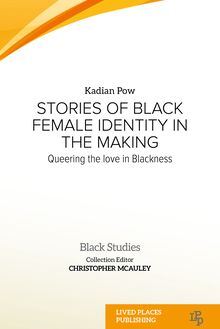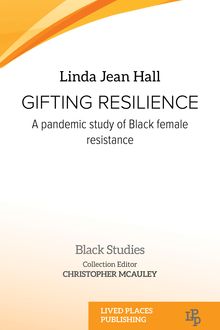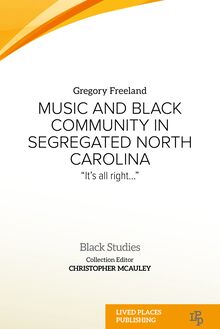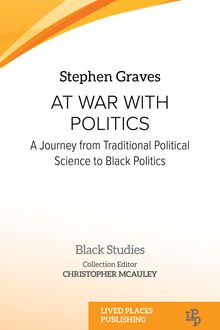-
 Univers
Univers
-
 Ebooks
Ebooks
-
 Livres audio
Livres audio
-
 Presse
Presse
-
 Podcasts
Podcasts
-
 BD
BD
-
 Documents
Documents
-
- Cours
- Révisions
- Ressources pédagogiques
- Sciences de l’éducation
- Manuels scolaires
- Langues
- Travaux de classe
- Annales de BEP
- Etudes supérieures
- Maternelle et primaire
- Fiches de lecture
- Orientation scolaire
- Méthodologie
- Corrigés de devoir
- Annales d’examens et concours
- Annales du bac
- Annales du brevet
- Rapports de stage
La lecture à portée de main
Vous pourrez modifier la taille du texte de cet ouvrage
Découvre YouScribe en t'inscrivant gratuitement
Je m'inscrisDécouvre YouScribe en t'inscrivant gratuitement
Je m'inscrisEn savoir plus
Vous pourrez modifier la taille du texte de cet ouvrage
En savoir plus

Description
How does the concept of love fit with Black identity?
When Black Lives Matter activist Marissa Johnson was pressed to address why she “hates white people”, she responded with this question: do you love Black people? This book is an exploration of the issues raised by this radical question – a refusal to centre Black identity on whiteness, a question of how love, and self-love, fit with Black identity, and a queering of how Black identity is understood.
Told through autobiographical reflection, this book contains the story of one Black woman’s process of iterative identity formation, grappling with the intersections of sexuality, gender, self-image, and love. Focusing on lived experience, the book places theories in context, exploring what ideas look like when applied to real life, making it invaluable reading for Black Studies and related courses.
0: Introduction
1: Welcome to America
2: Learning to be Black and female: an American dilemma
3: Black liberation, who? Black liberation, what?
4: White supremacy is whack
5: Ex-church girl
6: Sex and the Black Christian girl
7: The road to Queerville
8: Love as a mission
Sujets
Philosophie
Philosophie de la psychologie
Women's Studies
African Studies
Ethnic Studies
Black Studies
Social Psychology
Social Science
Cultural
PHILOSOPHY
EDUCATION
Sociologie, société et politique
América
Higher
Intersectionality
Afro-Caribbean
Level
African American studies
Anti-racism
Femininity
Cultural studies
School
Anthropology
American
Social
Discrimination
Informations
| Publié par | Lived Places Publishing |
| Date de parution | 22 juin 2023 |
| Nombre de lectures | 0 |
| EAN13 | 9781915271464 |
| Langue | English |
Informations légales : prix de location à la page 0,1250€. Cette information est donnée uniquement à titre indicatif conformément à la législation en vigueur.
Extrait
Stories of Black Female Identity in theMaking
Dr Kadian Pow
Stories of Black Female Identity in the Making
Queering the Love in Blackness
The Black Studies Collection
Collectioneditor
Dr Christopher McAuley
First published in 2023 by Lived Places Publishing All rights reserved. No part of this publication may be reproduced, stored in a retrieval system, or transmitted in any form or by any means, electronic, mechanical, photocopying, recording or otherwise, without prior permission in writing from the publisher. The authors and editors have made every effort to ensure the accuracy of information contained in this publication, but assume no responsibility for any errors, inaccuracies, inconsistencies and omissions. Likewise, every effort has been made to contact copyright holders. If any copyright material has been reproduced unwittingly and without permission the Publisher will gladly receive information enabling them to rectify any error or omission in subsequent editions. Copyright © 2023 Lived Places Publishing British Library Cataloguing in PublicationData A CIP record for this book is available from the British Library 9781915271471 ISBN: 9781915271457(pbk) ISBN: 9781915271471(ePDF) ISBN: 9781915271464(ePUB) The right of Kadian Pow to be identified as the Author of this work has been asserted by them in accordance with the Copyright, Design and Patents Act1988. Cover design by Fiachra McCarthy Book design by Rachel Trolove of Twin TrailDesign Typeset by Newgen PublishingUK Lived Places Publishing LongIsland New York11789 www.livedplacespublishing.com
Abstract
How does the concept of love fit with Black identity? This book is an exploration of the issues raised by this radical question—a refusal to center Black identity on whiteness; a question of how love, and self-love, fit with Black identity; and a queering of how Black identity is understood. Told through autobiographical reflection, this book contains the story of one Black woman’s process of iterative identity formation, grappling with the intersections of sexuality, gender, self-image, and love. Focusing on lived experience, the book places theories in context, exploring what ideas look like when applied to real life, making it an invaluable reading for Black Studies and related courses.
Keywords
intersectionality; African-American studies; Afro-Caribbean; LGBT+; femininity; lived experience; autobiography; sociology; race;gender
To my wife, Gillian, for loving me, for seeing me. I could not have finished this book withoutyou.
To my grandmother, Elizabeth, for knowing when to pull me close and when to let me find my way. I really like who I am, and a big part of that isyou.
To Kingston, Jamaica and Washington, DC, for inscribing a strong sense of racial identity.
To Bobigny and Livvie, for the cuddles and licks on the nose when I most neededthem.
To the Vendée coast of France, for providing the peace, serenity, and sunshine that helped me let go and let the wordsflow.
Notes on language
Jamaican patois, as a form of vernacular English native to the author, is used sparingly across several chapters in this book. Sometimes as a word, a phrase, or section of dialogue, wherever it appears, the intention is to convey a cultural layer of meaning for which standard English is insufficient. Wherever patois appears as a word or phrase, standard English translation appears in parentheticals. When it appears as dialogue, the paragraphs that follow will provide context to help the reader understand, but not a word-for-word translation.
African-American Vernacular English (AAVE), also used sparingly throughout the chapters, follows much in the same way as the appearance of patois. There are no parenthetical translations, but endnotes will sometimes provide more context.
The lack of direct translation for both forms of Black vernacular English is intentional, but none of the language is difficult to decipher.
Contents Learning objectives Introduction Chapter 1 Welcome to America Chapter 2 Learning to be Black and female: an American dilemma Chapter 3 Black liberation, who? Black liberation, what? Chapter 4 White supremacy is whack Chapter 5 Ex-church girl Chapter 6 Sex and the Black Christian girl Chapter 7 The road to Queerville Chapter 8 Love as a mission Notes Discussion questions References Recommended further reading Index
Learning objectives
1. To explore the ways in which Black identity is shaped by the confrontations between societal forces and domestic forces.
2. To grapple with how whiteness and feminism interact to produce exclusion.
3. To consider how the messages of Christianity pervade societal institutions and make it easier to internalize harmful concepts like sexual shame, patriarchy, and white authority.
4. To examine sexuality as a complex spectrum which can be affected by many factors, not just genetics.
5. To consider the contours of love and how we apply its practice outside of romantic encounters.
Introduction
DOI: 9781915271464
If I didn’t define myself for myself, I would be crunched into other people’s fantasies for me and eatenalive.
AudreLorde
I often tell my students that the concept of intersectionality existed long before Kimberlé Crenshaw (1991) gave life to it as a legal and analytical framework. Her work has benefited scholars who have come after her, including me. But Crenshaw’s writings give us better insight into past voices, like Audre Lorde, who, through her writings, speeches, and activism, was mapping the margins long before “intersectionality” could roll off our tongues. In the same speech from which the opening quote is drawn, Lorde (1982) says, “There is no such thing as a single-issue struggle because we do not lead single-issue lives”. Intersectionality tries to illuminate exactly that: race, gender, sexuality, class, and more do not function in separate silos; they co-mingle in complex ways to produce discrimination and privilege. But it is important to understand that behind these big concepts are people whose lives and identities are determined by sociological forces as well as through self-determination. The former can shape the latter.
Lorde defined herself by several terms, each flowing meaningfully into the next: Black, lesbian, mother, warrior, poet. There is no “and” at the end because those terms co-exist; they are not in hierarchy. She arrived at these descriptions after struggle and joy, learning what to keep and what to discard along the way. Most importantly, she learned “to hold onto all the parts of me that served me, in spite of the pressure to express only one to the exclusion of all others” ( Lorde, 1982 ). The right to maintain that complex identity was not a solipsistic striving. She put that complexity into her writing and speeches, which live on for our benefit.
I am not comparing myself to Audre Lorde, but you should know she has inspired my approach to this book. The journey to define myself found in the chapters you will read aims to elucidate how race, gender, sexuality, immigration, religion, and love function in the lived experiences of one person.
This book is not representative of the African-American woman’s experience. First, I do not identify as African-American, preferring the expansiveness of “Black” instead. It leaves room for me to be both Jamaican and Black American. You will most frequently see “Black” instead of “African-American” in this book for that reason. You will read how both cultures impact my identity and perspectives differently at times. In fact, this book is not the definitive anything. Much like how in the brilliant A Black Lady Sketch Show , the “A" is doing a lot of work. This book represents a story, and a perspective on how Black identity is shaped. Its contents are defined as much by the experiences I had to exclude as the ones I did include. Oh, the stories that could fill another book! Be it the Tumblr essays about the TV show Scandal I used to churn out regularly 1 or the fiction I write, my observations and experiences have always implicitly informed my work. This book gives me the opportunity to make explicit connections between lived experiences and academic concepts that can sometimes feel slippery to grasp in authentic ways. I am an ethnographer, but I have written this more like memoir, dappled with sociological insights. The poet turned writer and mental health advocate Bassey Ikpi (2019) excavated her life to bring readers an understanding of living with bipolar disorder. She does so with beautifully wrought prose that is, at once, explicitly honest and protective; protective of her memories and the people in them, knowing that what she crafted for us to digest is the truth as she remembers, but, possibly, also a lie. We are only seeing through her lens. Our memories stitch together narratives from puzzle pieces, attempting to make sense of what we’ve been through. And so it is with thisbook.
Chapter 1: Welcome to America
My mother and I moved to the United States from Jamaica, to join the rest of our family who had been living in Washington DC for two years. The ways in which their Caribbean cultural attitudes would shape my perception of myself begin to unfold.
Chapter 2: Learning to be Black and female: an American dilemma
A Black woman is what I am, but not something I always understood how to be. Anyone who is Black in America must learn what such an identity is and how it is perceived in the wider, non-Black society. First, I write about what that was like coming to the USA as a non-American Black person, being shaped by 1980s and 1990s Washington, DC. Second, I talk about learning to be authentic to my own blackness when choosing which university to attend.
Chapter 3: Black liberation, who? Black liberation, what?
This chapter considers some of the external and internal barriers to feeling liberated as a Black person. I explore some unpopular reflections on the Black diasporic ada
-
 Univers
Univers
-
 Ebooks
Ebooks
-
 Livres audio
Livres audio
-
 Presse
Presse
-
 Podcasts
Podcasts
-
 BD
BD
-
 Documents
Documents
-
Jeunesse
-
Littérature
-
Ressources professionnelles
-
Santé et bien-être
-
Savoirs
-
Education
-
Loisirs et hobbies
-
Art, musique et cinéma
-
Actualité et débat de société
-
Jeunesse
-
Littérature
-
Ressources professionnelles
-
Santé et bien-être
-
Savoirs
-
Education
-
Loisirs et hobbies
-
Art, musique et cinéma
-
Actualité et débat de société
-
Actualités
-
Lifestyle
-
Presse jeunesse
-
Presse professionnelle
-
Pratique
-
Presse sportive
-
Presse internationale
-
Culture & Médias
-
Action et Aventures
-
Science-fiction et Fantasy
-
Société
-
Jeunesse
-
Littérature
-
Ressources professionnelles
-
Santé et bien-être
-
Savoirs
-
Education
-
Loisirs et hobbies
-
Art, musique et cinéma
-
Actualité et débat de société
- Cours
- Révisions
- Ressources pédagogiques
- Sciences de l’éducation
- Manuels scolaires
- Langues
- Travaux de classe
- Annales de BEP
- Etudes supérieures
- Maternelle et primaire
- Fiches de lecture
- Orientation scolaire
- Méthodologie
- Corrigés de devoir
- Annales d’examens et concours
- Annales du bac
- Annales du brevet
- Rapports de stage











